MaxPreps scours the nation to discover fields and arenas that don't fit the stereotypical mold.
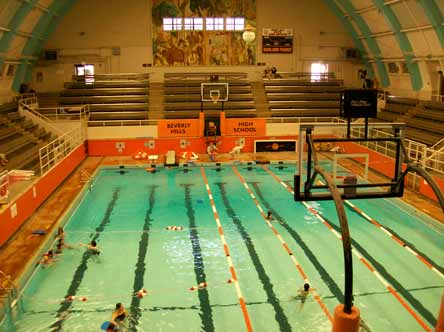
The Swim Gym at Beverly Hills High School hosts sports that don't seem to go together: Swimming/water polo and basketball/volleyball. Large motors push two halves of the wood floor over the pool. The gym is just one of a handful of America's unique high school sports venues.
Photo by Leland Gordon
Swimming pools are easy to find at most high schools. Just walk around outside and eventually you'll see a nice big spot where the ground was dug and a pool was built.
At two American high schools, you won't find the pool outside — or above ground.
It's an example of how some athletic venues don't fit the stereotypical standard of where a pool should be built. There are also baseball fields with additional obstacles in the field of play, indoor football and soccer fields and a basketball gym that fits nearly 10,000 people.
MaxPreps takes a look at some of the unique high school sports venues in the nation, knowing that these are not so much the Top 10, just 10 selections. There are undoubtedly more places that could make the cut.
MAXPREPS' 10 UNIQUE HIGH SCHOOL SPORTS VENUES
1. Swim Gym — Beverly Hills, Calif.
Way back in 1946, the iconic film "It's a Wonderful Life" showed America what is perhaps still the most unique spot where high school sports are contested. Mickey, played by Mark Roberts, tells Freddie Othello, played by Carl "Alfalfa" Switzer: "What's the matter, Othello? Jealous? Did you know there's a swimming
pool under this floor? And did you know that button behind you causes
this floor to open up? And did you further know that George Bailey (Jimmy Stewart) is
dancing right over that crack?
I've got the key!"
The turn of a key and the press of a button makes the
Beverly Hills (Calif.) basketball floor spread from the center, revealing a swimming pool underneath. The combination of the two give the Normans' little arena the "Swim Gym" name.
"Basically there are two, large motors on each side of the gym that do
all of the dirty work, with guide tracks for the floor to roll on. It
is all controlled by turning a key at a control panel located at about
midcourt," BHHS swimming and water polo coach Rob Bowie said in an email. "I happen to be one of the very few people entrusted with the
opening and closing of the court. Over the years pool ladders, mops,
trash cans, basketballs, volleyballs, water polo balls and numerous
other objects have fallen victim to the undeniable, trash-compactor like
force of the Swim Gym floor."
Many facilities can be described as multi-use, but takes a rare approach by combining a pool and gym floor. It was constructed in 1939 by the Works Progress Administration and is still standing, though Bowie said there are a couple shortcomings. The swimming pool features seven lanes, instead of the customary eight,
because that's how many lanes fit under a basketball court. And the pool
has a shallow end, so Beverly Hills can't host water polo playoff
matches at the Swim Gym.
Last year, a flood from a bathroom warped the basketball floor as it sat under bleachers, and a motor gave out. The floor just hasn't been the same after the flood even though it was replaced and maintenance staff found out they couldn't replace the motor because of its age.
"When things like this happen it leaves us without
not only a basketball court, but also a swimming pool," Bowie said. "While the Swim Gym is indeed a unique facility with lots of charm and
character, no doubt worthy of the historic building distinction, I think
it is safe to say that it has outlived its usefulness."
Continue reading{PAGEBREAK}
2. Round Valley Ensphere — Eagar, Ariz.
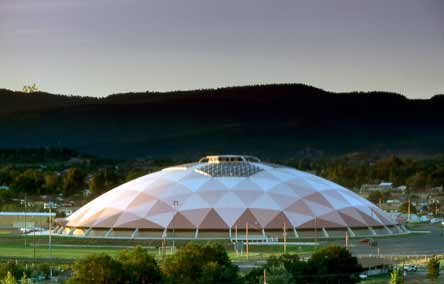
The Round Valley Ensphere is the first indoor high school football venue in America, at an elevation of more than 7,000 feet in eastern Arizona.
Photo courtesy of SPS+ Architects
In
this high-altitude area of Arizona near the New Mexico border, around
7,000 feet above sea level, lives the eighth largest geodesic dome
structure in the world. It's the first domed high school football stadium
in the United States, and it can host a football game, tennis match and
basketball or volleyball game all at the same time.
Round Valley (Eagar, Ariz.) uses the Ensphere for football, basketball, track, wrestling, volleyball and tennis. And sometimes two at once.
"During winter sports we have two big wooden courts so we
might do varsity boys on one side and then on the other side freshman
girls at the same time," said Guy Phelps, athletic director. "Around the end of football season it gets really cold up here."
There's
about 189,000 square feet of space and the building was constructed for
$11 million and finished in 1991, according to the "Off the Beaten Path Arizona: A Guide to Unique Places" book. Eagar has about 4,500 residents.
Phelps
said it's quite a home-field advantage, and the Ensphere can get very
loud. On the flip side, he added, it can be hard for Round Valley teams to
play outdoors on the road.
Interestingly, ensphere is actually a
verb, not a noun. And also of note, President George W. Bush has visited
the Ensphere, though it was during destructive wildfires that hit
eastern Arizona in 2002.
Continue reading{PAGEBREAK}
3. Holt-Moffitt Field — Lexington, N.C.
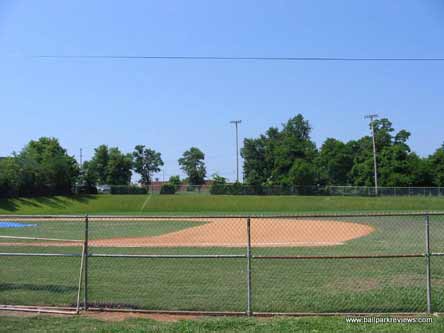
Holt-Moffitt Field features a hill in play, so left fielders might have to do some climbing to catch fly balls.
Photo courtesy of Ballparkreviews.com
Catching a deep fly ball in left field requires a significant elevation change at this former minor league baseball facility.
Holt-Moffitt
Field features a slope in left field that rises well above the
otherwise flat field. The top height of the hill isn't exactly known,
but
Lexington (N.C.)
coach Sam Mackey estimates that the top of the hill is about 25 feet
higher than the rest of the field. It's sloped but steep, and wraps from
foul territory near third base all the way to center field. It's 324
feet down the left field line but with the elevation change, it takes
about a 350-foot shot to clear the fence, Mackey said.
"There's
been many guys who run and when they get to the hill their foot patterns
are the same and they just eat it. You really have to know how to play
that field," Mackey said. "Every school that comes in and plays us here,
they never get another shot to play in a ballpark like that."
Word has it that Bobby Bonds and Ted
Williams once played at Holt-Moffitt Field, while these days, just
Lexington High and the local American Legion teams call it home.
Mackey's
team has found a way to make the hill work in its favor aside from the
intimidation factor. Players use the hill for conditioning drills.
Continue reading{PAGEBREAK}
4. New Castle Fieldhouse — New Castle, Ind.
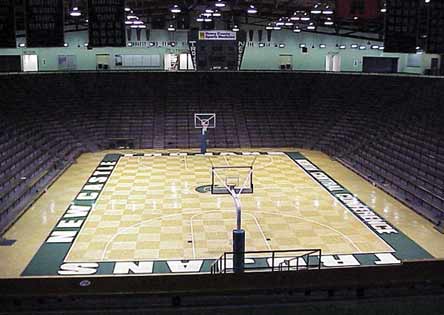
New Castle Fieldhouse can fit more spectators than some NCAA basketball venues.
Photo courtesy of WKPW FM
Two
situations make this place one of America's most unique venues. When
it's completely full the New Castle Fieldhouse is like something from
the NCAA. And when it only has a smattering of fans, it's like playing
in an airplane hangar.
Constructed for the 1959-60 school year,
the Fieldhouse was built for a big home-court advantage, according to
John Hodge, sports editor for the New Castle Courier Times. It must
work:
New Castle (Ind.) (which is dropping Chrysler from the school name this summer) is 107-37 over the past six seasons.
"Sites for the state tournament were based on capacity and New Castle was in
a regional tournament with nearby Muncie schools and Muncie had a
large fieldhouse. Every year, New Castle would go to Muncie and have to
play the Muncie teams in their gym and get beat. So New Castle said 'Let's
build one of our own.'"
According to a piece from USA Today, New
Castle Fieldhouse has the biggest capacity in America when it comes to
on-campus gymnasiums. It also has a 1/7-mile track around the top
concourse and a 6-acre parking lot. Basketball is the most popular
reason the building was constructed, but New Castle Chrysler also has a
very successful wrestling program.
Accounts online have the capacity listed as either 9,235 or 9,325, and temporary bleachers can make it even bigger.
"I'll
be honest, it's been a few years since they used the temporary
bleachers. Basketball is
not the huge draw it used to be," Hodge said. "It's still an excellent
place to
watch a game. People who come to visit, it's one of the first things
they want to see. In order to get full appreciation for it, it has to be
close to
full."
Continue reading{PAGEBREAK}
5. Quigley Stadium — West Haven, Conn.
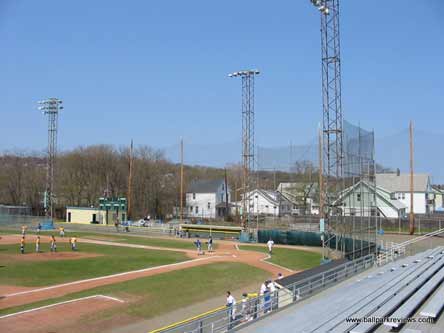
Quigley Stadium, an old minor league ballpark, has light standards that are in play, potentially causing havoc on balls that hit them.
Photo courtesy of Ballparkreviews.com
There's grass on the field of play. There's dirt, there's bases and there's some chalk too. Oh, and there are some light standards as well.
This former minor league ballpark, home of the defending state champion
Notre Dame (West Haven, Conn.) baseball team, has the bases of most of its light towers within the field of play. Umpires, players and coaches alike have to study up on the ground rules for when a ball hits the standards.
"There's a ground rule that if it hits the light standard at a certain point it's this and if it's above it's a home run. The ground rules take a minute," athletic director Tom Marcucci said. "If it's below the fence line and hits the light standard and comes back in, they play it like a wall."
There is padding around the bottoms of the light standards, but it's still going to hurt if a player slams into one. And if a ball hits low enough on the light standard, it's a guessing game as to where the ball might ricochet to.
"It's a unique and strange place," Marcucci said. "Because it was used for football for so many years you had the combination of different lines on the field, in terms of sidelines for football getting confused with foul lines. It's not a home field advantage at all, though."
From 1973-81 the field hosted an Eastern League team and up until recently, was also used for high school football. Now, it's just for amateur baseball.
Continue reading{PAGEBREAK}
6. Wally Streeter Pool — Tacoma, Wash.
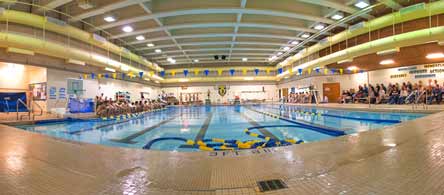
The swimming pool at Stadium High School isn't unique because it's indoors. It's unique because it's underground.
Photo courtesy of Dan McCormack
What are you most likely to find below most street surfaces? Dirt. Culverts. Sewers. Maybe even subway tunnels.
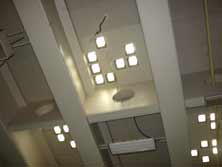
Natural light makes it to the WallyStreeter Pool through glass blocks.
Photo courtesy of James Catalanich
In Tacoma, they have something unique under a stretch of E Street: A swimming pool.
Stadium (Tacoma, Wash.)
actually has quite a few athletic facilities that draw attention.
There's tennis courts on top of a parking garage, and the football field
is fit snugly into a tight bowl that overlooks Commencement Bay, part
of the spectacular Puget Sound.
But the pool stands out among the athletic facilities at this school, which is on the National Register of Historic Places.
"There was controversy associated with the pool. The principal at the time had to choose between building a pool or an auxiliary gym," Athletic Director James Catalanich said. "He selected the pool because it would benefit a larger number of people."
The pool, named after longtime swim coach Wally Streeter, was constructed in 1988 for about $5 million and is used for swimming and water polo. There's even glass blocks on top for some natural light. While it is under a street, that street is no longer open to traffic, so swimmers aren't doing their work under a bunch of moving Fords, Chevys and BMWs.
The underground aspect adds some quirks, said Joy Keniston-Longrie, a Stadium Booster Club member.
"It feels like a tropical cavern due to the humidity. It's loud and it echoes," she said, adding that it has a reputation as a fast pool. "It is scary when the lights go out because it's pitch black."
Continue reading{PAGEBREAK}
7. Alaska Dome — Anchorage, Alaska
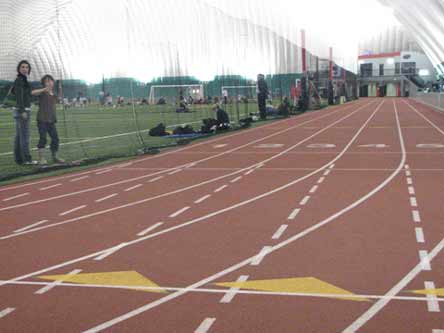
It's not uncommon to see soccer and track share a venue. It is uncommon to see that in an indoor venue. The harsh Alaska weather pushes prep sports indoors sometimes, and the Alaska Dome can handle both.
Photo courtesy of the Alaska Dome
In
Anchorage, the term "indoor soccer" doesn't mean a tiny field with
walls and no out-of-bounds calls, like it does it most other areas. It
means that the unforgiving Alaska weather has an oppressive hold on all
the outdoor fields.
That weather also stifles other sports, so
the Alaska Dome is where prep sports go when the snow, ice, rain, wind
and temperatures make venues unplayable. The average high temperature is
below freezing four months of the year in Anchorage with an average of
16 inches of rain and nearly 60 inches of snow every year, which means
outdoor events are at the mercy of the weather report.
"It's been a great thing for soccer players," Chugiak High girls soccer
coach Paul Brehmer said. "All games are in the dome until turf fields
are cleared by the school districts."
Chief Executive Officer Alice Federenko said
Service (Anchorage),
South (Anchorage),
East (Anchorage),
Bartlett (Anchorage),
West (Anchorage),
Eagle River,
Chugiak (Eagle River) and
Dimond (Anchorage)
have played home soccer games in the facility. Also, the Al-Aska Shrine
Football All-Star Game comes to the Alaska Dome every October.
Track
is the other big high school sport at The Dome. The rubber track is 400 meters long but has six
lanes, compared to eight at most tracks. There is also space for all the field events as well.
Indoor
soccer and track make the venue unique. And as a building, it's also in
a class of its own. The Alaska Dome is North America's largest
structure of its kind, measuring 601 feet by 290 feet and 87.5 feet
tall.
Continue reading{PAGEBREAK}
8. Keyport High — Keyport, N.J.
View Larger Map
Outfielders chasing down a ball in the outfield here might also end up committing a lane violation. There's no outfield fence at
Keyport (N.J.) and the track is in play in right and center fields, which can lead to some awkward pursuits of balls hit in the gap.
The plot of land at Keyport is just too small to fit both baseball and track, so concessions had to be made. And though many efforts have been made to fix the problem, it stays as is for now.
"The poor centerfielder might be the one who would have to deal with the ball bouncing on the track surface or have to run from grass to track to grass," said Richard Siegel, an umpire in New Jersey. "Also, the track was not completely flat and flush with the actual grass surface."
Continue reading{PAGEBREAK}
9. Dunlavy Field — Sonora, Calif.
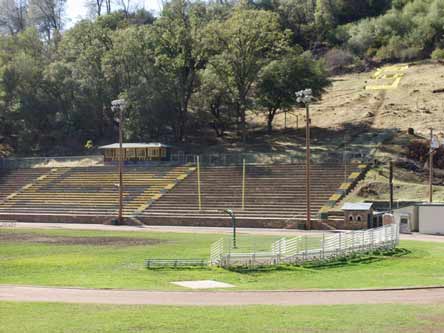
Dunlavy Field was built by the Works Progress Administration and reflects the natural environment around it.
Photo courtesy of Gray Brechin
Dunlavy Stadium, home of
Sonora (Calif.) football, grabs attention for where it is, who built it and when it was built.
The Great Depression-era Works Progress Administration constructed the stadium in the old Gold Rush mining town of Sonora, a couple hours east of San Francisco in the Sierra Nevada foothills. And they tucked the concrete bleachers (which used to have wood seatbacks) into an area that still features the ruggedness and beauty of the natural environment. Bright fall foliage, oak trees, creeks and a hill dominate the scenery at Dunlavy Stadium — not prefabricated metal bleachers and asphalt parking lots that are found at many other high school football stadiums.
"We all love that it is nestled behind a large hill and the sun drops behind it early in the evening, so even on the hottest days we have a shady field," head coach Bryan Craig said. "Coming
down from our locker room, hearing our band and the smell of barbecue in the
air, puts chills up my spine. This is my third year as head varsity
coach but my 21st year at
Sonora and I still get that feeling on game night."
The stadium, made of rock and concrete, was dedicated on Sept. 24, 1937 and capacity is about 5,000 people. Sonora's population is around 4,900.
All the fans sit on one side in the same concrete bleachers, and those fans also have to cross a footbridge over Wood Creek to get into the stadium.
Continue reading{PAGEBREAK}
10. Pierce High — Arbuckle, Calif.
View Larger Map>
Similar to Holt-Moffitt Field, the baseball field at Pierce features a raised surface in play. There are two major differences: First, the hill is much smaller. Second, the hill is right behind second base.
"The inside of the track has a
raised grass field that would result in odd bounces from balls hit up
the middle," said MaxPreps staff writer Kevin Askeland, who coached against Pierce one season. "The bump has since been lowered for a more level surface."
The football field is the outfield at Pierce and that means the goalposts are in the field of play. It takes a long blast to reach the goalpost in right field but it's much more reachable in left. And perhaps the most distracting part of all is that there is a football snack bar along the right field line, just a foot into foul territory.
To top it off, the field at Pierce is located right beside Interstate 5. Foul balls hit off to the left can easily find their way into the flow of 70-mph traffic traversing the highway in far northern California.